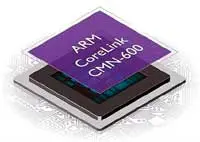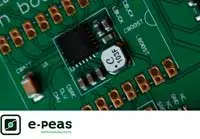Electronics News
Archive : 28 September 2016 год
 ARM has launched the third generation of its coherent backplane technology which it says has been optimised for next generation intelligent connected systems, including 5G networks and industrial systems.
ARM has launched the third generation of its coherent backplane technology which it says has been optimised for next generation intelligent connected systems, including 5G networks and industrial systems.
Between them, the CoreLink CMN-600 coherent mesh network and DMC-620 dynamic memory controller are said to improve data throughput by a factor of five, halve memory latency and support SoCs with up to 128 ARMv8A cores.
Jeff Defillipi, senior product manager with ARM’s System IP group, said the development was in response to the increase in the number of connected devices. “VR is becoming more prevalent,” he offered, “and streaming VR requires a constant high bandwidth, which is extremely demanding.”
A further target for the new backplane IP is autonomous vehicles. “But we probably won’t see truly autonomous vehicles until we have car to car communications, enabling real time decisions,” he continued.
According to Defillipi, the latest additions to the backplane IP portfolio are based on a new architecture and will take products into the next decade. “The IP is built on the AMBA5 CHI; the highest performing AMBA bus,” he said.
Other new features include intelligent cache allocation. “This is software configurable,” Defillipi noted, “and can boost the performance of networks when passing packets. I/O devices can also decide whether they want to access cache or main memory.”
Although applicable in SoCs with up to 128 cores, Defillipi says 64 cores will be the ‘sweet spot’.
Author
Graham Pitcher
Source: www.newelectronics.co.uk
 Research led by the University of Southampton claims that memristors could enable the development of implants that use electrical signals from the brain to help treat medical conditions.
Research led by the University of Southampton claims that memristors could enable the development of implants that use electrical signals from the brain to help treat medical conditions.
In a study published in Nature Communications, the researchers showed that memristors could provide real time processing of neuronal signals, leading to efficient data compression and the potential to develop more precise and affordable neuroprosthetics and bioelectronic medicines.
While monitoring the activity of neuronal cells is fundamental to neuroscience and the development of neuroprosthetics, a persistent problem is said to be the inability of devices to process neural data in real-time.
Looking to address these issues, the team developed a nanoscale Memristive Integrating Sensor (MIS) into which they fed a series of voltage-time samples, replicating neuronal electrical activity.
Acting like synapses in the brain, the metal oxide MIS was able to encode and compress by up to 200 times neuronal spiking activity recorded by multi-electrode arrays. Besides addressing the bandwidth constraints, this approach was also found to be power efficient – up to 100 times less per channel when compared to current best practice.
Dr Themis Prodromakis, Reader in Nanoelectronics, said: “We are thrilled that we succeeded in demonstrating that these emerging nanoscale devices, despite being rather simple in architecture, possess ultra rich dynamics that can be harnessed beyond the obvious memory applications to address the fundamental constraints in bandwidth and power that currently prohibit scaling neural interfaces beyond 1000 recording channels.”
Postgraduate researcher Isha Gupta added: “Our work can significantly contribute towards further enhancing the understanding of neuroscience, developing neuroprosthetics and bioelectronic medicines by building tools essential for interpreting the big data in a more effective way.”
The research, supported by an FP7 project involved the University of Southampton, the University of Padova and the Max Planck Institute.
Author
Graham Pitcher
Source: www.newelectronics.co.uk
 e-peas, a start-up based in Liege, has announced the commercial availability of its first low power IC - the AEM10940. The chip looks to maximize the efficiency with which electronic hardware scavenges or draws energy from the ambient environment.
e-peas, a start-up based in Liege, has announced the commercial availability of its first low power IC - the AEM10940. The chip looks to maximize the efficiency with which electronic hardware scavenges or draws energy from the ambient environment.
Highly integrated the AEM10940 has a 94% power boost converter, along with voltage reference, energy management and LDO regulator elements. The IC’s cold-start circuitry means that the device can be brought into active operation even when there is minimal energy left - an input voltage of just 380mV and a mere 11μW of power proving to be more than sufficient.
The IC harvests available input power up to 50mW from an allocated energy source, such as a photovoltaic cell.
Its boost converter (which has an input voltage range that spans from 100mV to 2.5V) exploits this for the rapid charging of any connected energy storage reserve, such as a Li-Ion battery, thin film battery, or conventional-/super-capacitor.
The 2 embedded LDO regulators deliver close to 98% current efficiency across a broad load range. Respectively, these have a low voltage and a high voltage supply associated with them. The low voltage supply (1.8V), which can provide up to 10mA load current, is typically used to drive the system’s microcontroller. The high voltage supply, which is configurable between 2.2V and 4.2V, can sustain up to 80mA of load current and will normally take care of tasks like powering the system’s wireless transceiver (which could be based, for example, on either BLE, Zigbee, SigFox or LoRa).
“The AEM10940 will be pivotal in meeting the demands of a host of new systems where every mJ of energy is certain to be precious," explained Thierry Keutgen, Product Marketing Director of e-peas. "The versatility of this IC means it will work with all types of DC energy harvesting apparatus and all types of energy storage technology,”
Author
Neil Tyler
Source: www.newelectronics.co.uk

